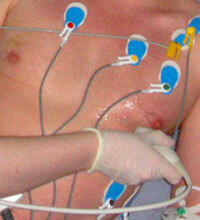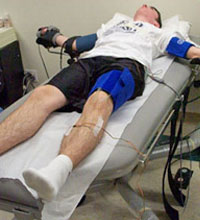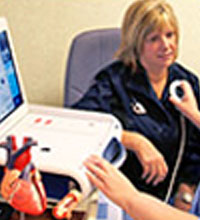Our Services

24hr Blood Pressure Monitoring
How is it done?
A cuff similar to a blood pressure cuff you would see in your doctor’s office is placed on the non-dominant arm.
A long tube is connected from the cuff to a monitor about the size of an old cassette walkman. This monitor is placed on a belt around your waist.
The tubing is placed underneath the clothing so that clothing can be easily removed and replaced.
When the cuff is inflating it is important to keep that arm still and relaxed for the duration of the measurement which usually takes around 30sec to 1min. This rule can be ignored if you are driving.
A diary will be given to write down the times any blood pressure medications are taken and to document any exercise performed during the recording period.

Dobutamine Stress Echocardiogram
What is a Dobutamine Stress Echocardiogram
A dobutamine stress echo is a non-invasive test used to evaluate the function of the heart while it is subjected to stress. The heart will be ‘stressed’ by a medication called Dobutamine.
Dobutamine affects the heart in a similar manner to exercise. It increases the heart rate and blood pressure and makes the heart beat stronger. The rise in heart rate increases the oxygen demand of the heart and helps to determine if the heart muscle is getting enough blood and oxygen.

Electrocardiogram (ECG)
What is an Electrocardiogram?
The electrocardiogram is a recording of the electrical activity of the heart. The heart has the ability to generate its own beat. The ability of the heart to generate its own beat resides in the specialized cardiac conduction tissue. The way this impulse is generated is very complex but in simple terms sodium, potassium and calcium ions are transferred between the outside and inside of the heart cell. This then causes an electrical current to flow which generates the heart beat. This electrical activity is transmitted throughout the body’s tissues and can be measured on the skin’s surface.
In 1901 Dr Willem Einthoven invented a very sensitive electrical monitoring which could measure these very small electrical signals which are evident at the skin’s surface. The recording of these signals has been standardized into what is known today as the 12 lead ECG.

Exercise Stress Test
What is an Exercise Stress Test?
An exercise stress test is a non-invasive test used to evaluate the function of the heart while it is subjected to stress. This is achieved by walking on a treadmill.
Exercise increases the heart rate and blood pressure and makes the heart beat stronger. This test is performed to help diagnose blocked arteries in the heart (coronary artery disease), assess abnormal heart beats or to check the function of pacemakers.

Holter Monitoring
What is a Holter Monitor?
The Holter monitor is a device very similar to the electrocardiogram in that it will record the electrical activity of the heart that is transmitted through to the skin surface. The standard 12 lead electrocardiogram records 10 seconds of heart rhythm however, for patients who are having intermittent rapid or slow heart beats it may not be captured on the standard 12 lead ECG and thus a more extended period of monitoring is required.
The Holter monitor was developed by Dr Norman J Holter who invented telemetric cardiac monitoring in 1949. The Holter monitor can record up to 48 hours of continuous cardiac rhythm. It can also provide trend data and will generally catalogue any abnormal rhythms that are present.

Cardiology Consultation
What is an Cardiology Consultation
Including advanced heart failure, cardiac transplantation workup and pulmonary hypertension management

Transthoracic Echocardiogram
What is a Transthoracic Echocardiogram?
A transthoracic echocardiogram is a test that takes images of the heart with the use of a transducer (probe) placed on the chest wall. Harmless ultrasound technology is used. High frequency sound waves inaudible to the human ear are sent from the probe and directed toward the heart. As the sound goes through the different structures, part of it bounces (echoes) back to the probe and is interpreted by the ultrasound machine into images of the beating heart. The images are then displayed on the monitor and recorded for future review.
At Queensland Cardiology, the test is performed by a sonographer trained in cardiac ultrasound and is interpreted by a Cardiologist.

Exercise Stress Echocardiogram
What is an Exercise Stress Echocardiogram?
An exercise stress echo is a non-invasive test used to evaluate the function of the heart while it is subjected to stress. This is achieved by walking on a treadmill.
Exercise increases the heart rate and blood pressure and makes the heart beat stronger. The rise in heart rate increases the oxygen demands of the heart and helps us to determine if the heart muscle is getting enough blood supply through the coronary arteries.

Head Up Tilt Table Test
What is a Head Up Tilt Table Test?
A head up tilt test is a simple, non-invasive test used to evaluate patients who have had repeated “syncope” (loss of consciousness).
How does the test apply to you?
Normally when we stand, the heart and blood vessels (cardiovascular system) make adjustments to prevent blood from pooling in the legs and maintain blood flow towards the head. For example, the heart rate increases and the blood vessels constrict. However, in some patients, these cardiovascular adjustments do not occur as they should, resulting in a drop in blood pressure and or heart rate causing syncope (fainting).

Pacemaker/Defibrillator Testing
What is a Pacemaker/Defibrillator
Testing
Coming soon content
